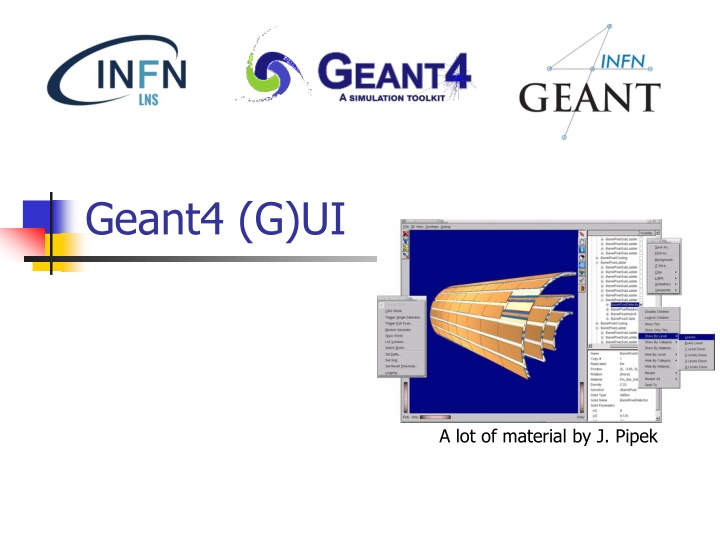
Steering Geant4 Simulation: Control Methods & Implementation
Explore three ways to control Geant4 simulation - hard-coded in C++, batch session commands, and interactive real-time inputs. Learn how to select and implement each method using code examples. Discover macro file usage for specifying simulation parameters and executing commands within the application.
Uploaded on | 0 Views
Download Presentation

Please find below an Image/Link to download the presentation.
The content on the website is provided AS IS for your information and personal use only. It may not be sold, licensed, or shared on other websites without obtaining consent from the author. If you encounter any issues during the download, it is possible that the publisher has removed the file from their server.
You are allowed to download the files provided on this website for personal or commercial use, subject to the condition that they are used lawfully. All files are the property of their respective owners.
The content on the website is provided AS IS for your information and personal use only. It may not be sold, licensed, or shared on other websites without obtaining consent from the author.
E N D
Presentation Transcript
Geant4 (G)UI A lot of material by J. Pipek
Three ways of steering the simulation 1) hard-coded application no user interaction everything specified in the C++ source re-compile needed to apply changes 2) batch session commands in external macro file 3) interactive session real-time command input by user textual, graphical, (network-based)
Select the way of control main.cc int main(int argc, char** argv) { G4RunManager* runManager = new G4RunManager; runManager->SetUserInitialization(new MyDetectorConstruction()); // Physics list G4VModularPhysicsList* physicsList = new MyPhysicsList; physicsList->SetVerboseLevel(1); runManager->SetUserInitialization(physicsList); // User actions initialization runManager->SetUserInitialization(new MyActionInitialization()); Insert the control code here! delete runManager; }
Hard-coded C++ // ... // User actions initialization runManager->SetUserInitialization(new MyActionInitialization()); runManager->Initialize(); runManager->BeamOn(1000); // ... delete runManager; } You must initialize and start the run by issuing beam on Even the number of events has to be specified!
Batch session // ... // User actions initialization runManager->SetUserInitialization(new MyActionInitialization()); G4UImanager* UImanager = G4UImanager::GetUIpointer(); G4String command = "/control/execute "; G4String fileName = argv[1]; UImanager->ApplyCommand(command + fileName); // ... delete runManager; } This example gets the file name of the macro from the command-line argument: ./myApplication my-macro.mac
Macro file: example basic/B1 exampleB1.mac # Initialize the run (necessary) /run/initialize # gamma 6 MeV /gun/particle gamma /gun/energy 6 MeV /run/printProgress 100 /run/beamOn 1000 Meaning of these commands will be explained later # proton 210 MeV /gun/particle proton /gun/energy 210 MeV /run/beamOn 1000 The contents of the file, excluding #comments, are executed line by line in the application ( previous slide)
Interactive session Many different session types, inheriting from G4UIsession class: command-line based (dumb terminal) graphical special your own? G4UIExecutive class enabling to select the appropriate session at runtime, based on the environment variables (recommended)
3a: Concrete UI session // ... G4UIsession* session = new G4UIterminal(); session->StartSession(); delete session; // ... Select one of the concrete clases Session types: G4UIterminal command-line (like C-shell) G4UI(t)csh csh- or tcsh-like specific terminal G4UIQt modern graphical UI (recommended) G4UIWin32 for windows only G4UIWt experimental web-browser based G4UIGAG for GAG java UI
G4UIQt session Visualization Icons Output (Cout) Command tree Command input
3b G4UIExecutive G4UIExecutive behaves like a G4UIsession, but it selects the most appropriate concrete session: from constructor argument from environment variables: G4UI_USE_QT, ... from $HOME/.g4Session file from the list (first that applies): Available UI session types: [Qt, GAG, tcsh, csh] See from hands-on session // ... G4UIExecutive* ui = new G4UIExecutive(argc, argv); ui->SessionStart(); delete ui; // ... You may add a third argument here, i.e. the session name 10
Universal batch/interactive approach int main(int argc, char** argv) { // ... if (argc == 1) { // Interactive mode G4UIExecutive* ui = new G4UIExecutive(argc, argv); ui->SessionStart(); delete ui; No argument One argument (or more) } else { // Batch mode G4UImanager* UImanager = G4UImanager::GetUIpointer(); G4String command = "/control/execute "; G4String fileName = argv[1]; UImanager->ApplyCommand(command + fileName); } // ... Mode selected based on application argument: No argument = interactive mode One argument = batch mode
Executing macro commands Hard-coded (!) // ... G4UImanager* UImanager = G4UImanager::GetUIpointer(); G4String command = "put your command here"; UImanager->ApplyCommand(command); // ... Batch session put the command in the macro file Interactive session just type the command in the window or in the terminal line
Example UI commands: a few useful ones /run/verbose 1 sets how much output the run manager will print (similar for other classes) /run/initialize initializes the run (constructing the geometry, physics and preparing the user actions) /run/beamOn 100 starts a run with 100 events /control/execute macroName run all commands contained in a macro file A complete list of built-in commands is available in the Geant4 Application Developers Guide, Chapter 7.1
Hands-on All slides (so far) available in http://indico.ihep.ac.cn/event/9624/ Let us start with the exercises: http://202.122.35.42/introduction Bookmark this link: all exercises will be uploaded here Now task0 available
